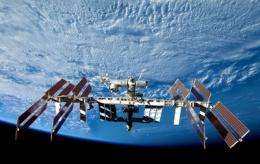Ten more years for the ISS

A lot can happen in 10 years. Over the past decade an international laboratory, widely known but often under-appreciated, has been producing results at an extraordinary rate. Using its unique capabilities,
- engineers have developed a precision robotic arm that helps surgeons remove tumors from the human brain;
- experimenters have learned to start fires without flames—an anti-intuitive technology that could lead to super-efficient auto engines;
- physicists have counted hundreds of thousands of anti-matter particles among normal cosmic rays, a telltale sign of mysterious dark matter.;
- researchers have gathered atoms into exotic forms, creating the building blocks of futuristic smart materials;
…and much more.
That lab is the International Space Station.
"The accomplishments of the past 10 years are remarkable—especially considering that the space station was still under construction." notes Julie Robinson, program scientist for the ISS. "Now that the station is finished, we've been granted at least 10 more."
In January, the Obama Administration announced an extension of the International Space Station until at least 2024. The extra time allows NASA and other space agencies around the world to pursue a number of important goals.
For one thing, the ISS is crucial for long-duration travel through deep space. "That may sound ironic given that the space station never leaves Earth orbit," says Robinson, "but we have determined that research on station is necessary to mitigate 21 of 32 known human-health risks associated with long duration space missions. The road to Mars leads through the ISS."
She adds that medical research for astronauts helps people on Earth, too. Treatments for bone loss and muscle decay, and advances in telemedicine are just a few of the spin-offs that have made their way into hospital rooms since the ISS program began.
As the next ten years unfolds, a menagerie of "model organisms" will join astronauts on the ISS for advanced life science studies. New "crewmembers" include weeds, fruit flies and rodents—all of which share surprising amounts of DNA with humans. "By studying these organisms in microgravity, we will learn a lot about ourselves," she says.
Although Robinson has a degree in biology, some of her favorite experiments are in the area of fundamental physics. For instance, she says, "the station's Alpha Magnetic Spectrometer program, led by Nobel laureate Samuel Ting, is poised for breakthroughs on the nature of dark matter." Another exciting project is the Cold Atom Lab, slated for flight in 2016. "We are going to create the coldest spot in the known universe inside the ISS," she says. "This will allow researchers to study exotic forms of quantum matter such as Bose-Einstein condensates."
With the "big blue marble" looming large in its window, the space station is a powerful platform for Earth science. Sensors under construction and slated for launch in the next few years include instruments for hurricane forecasting, studies of the global climate, and lightning hazards. "The extension of the space station allows Earth science instruments to collect longer term datasets," notes Robinson. "Some of our existing sensors will collect 90% more data during the extra decade."
The station's 10-year extension also boosts the development of America's homegrown commercial space program. SpaceX and Orbital Sciences Corp., which have contracts to supply cargo to the station, can now look forward to competing for future contracts. SpaceX, Boeing and Sierra Nevada are also interested in launching crews to the station by 2017. As commercial providers provide access to Earth orbit at lower cost, we move toward the day when scientists will travel to space to do their own experiments, first-hand.
Provided by NASA



















